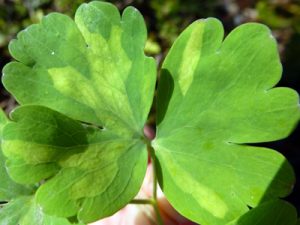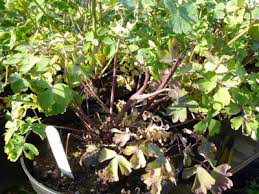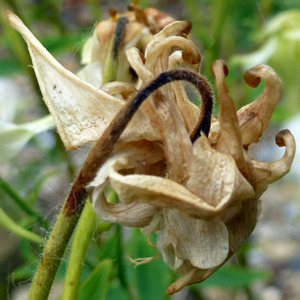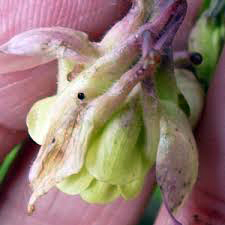Peronospora spp. – Aquilegia Downy Mildew (ADM)
 |
Peronospora spp. Family: Peronosporaceae Plant affected: Aquilegia (columbine) |
|
Aquilegia downy mildew (ADM) is spread by air- and water-borne spores. Can be carried long distances by the wind. Outbreaks typically occur when there are prolonged periods of rain in spring and/or late summer. Ideal conditions for production of spores and infection. While the airborne spores are only viable for a short time, the fungus is capable of producing a second type, called a resting spore, between the leaf tissues. These resting spores are more resilient. Released into the soil from decaying diseased material they can survive for several months, and perhaps for several years although this fact has not been confirmed.
The disease is so new, scientists have yet to assign a species name to the genus. While it has been placed in the same genus (Peronospora) as powdery mildew which also affects aquilegias, it is not related…despite certain similarities in symptoms.
Remedial Action: There is no chemical control for this disease. However, strict attention to hygiene in the prompt removal of any diseased parts or whole plants, as a non-chemical control method, will reduce the risk of resting spores contaminating the soil. Immediately burn diseased plants, or bag them for garbage removal. DO NOT COMPOST. The Royal Horticultural Society (RHS) has recommended not re-planting aquilegias in an affected area of the garden for at least a year. This advice may not have merit as there other species of Peronospora affecting other plant species which produce resting spores capable of surviving several years in the soil. Read more about Aquilegia Downy Mildew (ADM) in my Blog dated March 1, 2017. (Quick link here.)
Posted on February 14, 2018 |
|
Helleborus net necrosis virus – hellebore black death
Gymnosporangium sabinae – pear trellis rust









